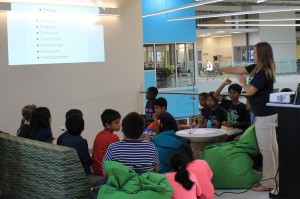By Alexandra Dalton
staff writer
@alex_dalton04
It took three years for the new Richard J. Lee Elementary School program to fully become a devised plan. Site visits, research, interviews and collaboration over the years helped perfect the plan for the new challenged-based program taking place at the new Coppell ISD campus.
This innovative net-zero program makes Lee the first elementary school of its kind in Texas. The net-zero program produces enough energy to match or even exceed the school’s energy consumption.
With the net-zero plan in place, Lee is conserving energy by using solar, wind and geothermal power, as well as collecting rain water for irrigating plants.
To save even more energy, solar tubes on the second story use sunlight to light all the spaces, not just those with windows. By harnessing its own power in renewable ways, it reduces the amount of electricity drawn from the power grid.

The goal is this school will determine how other schools in the Coppell Independent School District will be pioneered.
“Lee Elementary can be a school that others can learn from,” Principal Chantel Kastrounis said. “Data from Lee’s data dashboard will inform learners of the impact of their decisions in relation to water consumption, electric conservation, as well as our other energy saving processes we take part in.”
One of the central ideas is for students to learn how to take more of a role in conserving energy, giving them responsibility and pride in their school.
“We are working towards transferring responsibilities more towards the learners,” third grade teacher Elisa Farrell said. “They will eventually be responsible for giving tours of the building, creating the morning announcements in our broadcast studio and especially responsible when solving real-world problems.”
Another campus goal is teaching students real-world issues through experiencing the concepts in realistic settings.
“It will plant the seeds of responsibility, environmental and academic consciousness,” Farrell said. “The community will get to see a different way of learning and how it can benefit the community through service-learning projects.”
In hopes of fostering new learning techniques to spread these innovative ideas, not just energy saving processes in one area, Lee is opening students eyes to the school they attend and it’s benefits to the community.
“Richard J. Lee Elementary uses Challenge-Based Learning to empower leaders to create questions and share actionable solutions to real world problems,” Kastrounis said. “Learners share their solutions with the world and solicit feedback so that they can reiterate or improve upon their ideas.”
The school took advantage of the new experience to make an impression on their students long term.
“The physical environment fosters movement and collaboration,” Kastrounis said. “The sustainability feature of the building will help our learners have a better understanding of their impact on the word, and how even one decision they make could change an outcome.”
At this school, teaching is called designing, students are called learners and the areas of the school with a mixture of grades are called varied colored houses. Although the differences between pre-existing Coppell ISD schools and Lee elementary seem vast, the idea is the only difference is Lee Elementary is built to accommodate the flexible use of spaces and the building as a learning tool.
Having the new technologies right on campus makes a great example for the students to see up close the power of technology in learning.
“Instead of just talking about how plants use the sun to make energy, we can also talk about the solar panels on our roof that make energy for the school,” Farrell said. “We also have some great technology in the form of data signage that shows our current electricity savings and usage, which helps demonstrate real-world math and data analysis concepts.”
Students are not the only ones with new integrated thought processes. Kastrounis said teachers are implementing less traditional thinking to expand the minds of their students. By doing this, Kastrounis hopes to accomplish a more well rounded learning experience for everyone.
“My role is to get the educators the tools they need to teach what they need to teach,” Kastrounis said. “This could come in the form of professional learning, being a thought partner, inspiring them, or reminding them that we have endless possibilities in this new space.”
Inspiration is sure to come from this brand new, innovative school mixing it up. Focused on enforcing new habits and ideas, this new school hopes to change the Coppell community for the better.








